GMCT: Challenges and Solutions in Organizational Change
VerifiedAdded on 2021/04/24
|9
|2234
|63
Report
AI Summary
This report examines the change management challenges faced by Green Mountain Cellular Telephone Company (GMCT). The study identifies issues such as organizational structure conflicts, resistance to change from management, problems with key personnel, and an ineffective organizational culture. The report details how the general manager, Erik Peterson, struggled to implement changes due to these issues, including problems with subcontractors, employee compensation disparities, and difficulties in negotiating with local governments. The report analyzes these issues, drawing on academic literature, and recommends improvements to organizational structure, culture, and management's approach to change to facilitate a more successful and efficient cellular system implementation. The report suggests a flatter organizational structure and a more equitable culture to foster employee cooperation and overcome resistance to change.
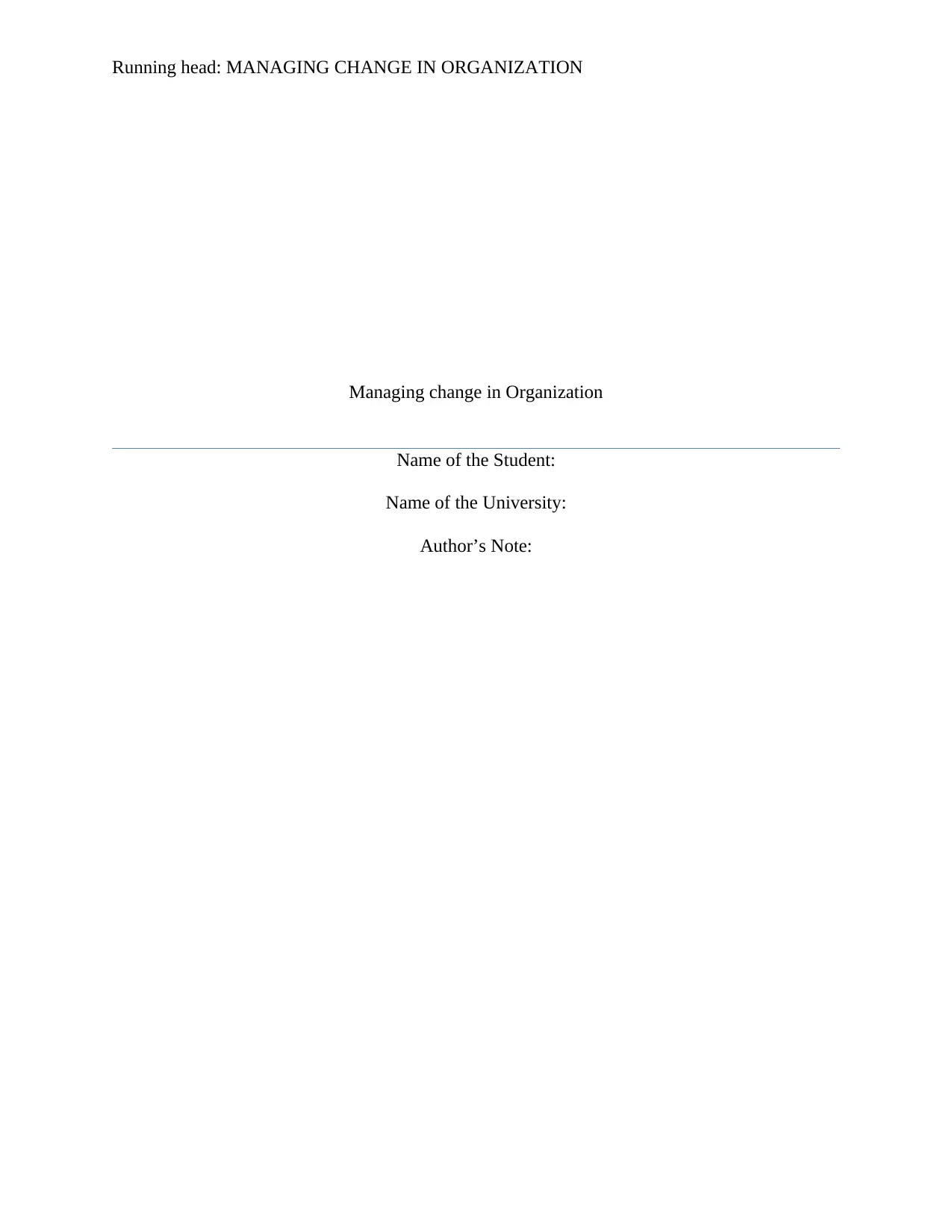
Running head: MANAGING CHANGE IN ORGANIZATION
Managing change in Organization
Name of the Student:
Name of the University:
Author’s Note:
Managing change in Organization
Name of the Student:
Name of the University:
Author’s Note:
Paraphrase This Document
Need a fresh take? Get an instant paraphrase of this document with our AI Paraphraser
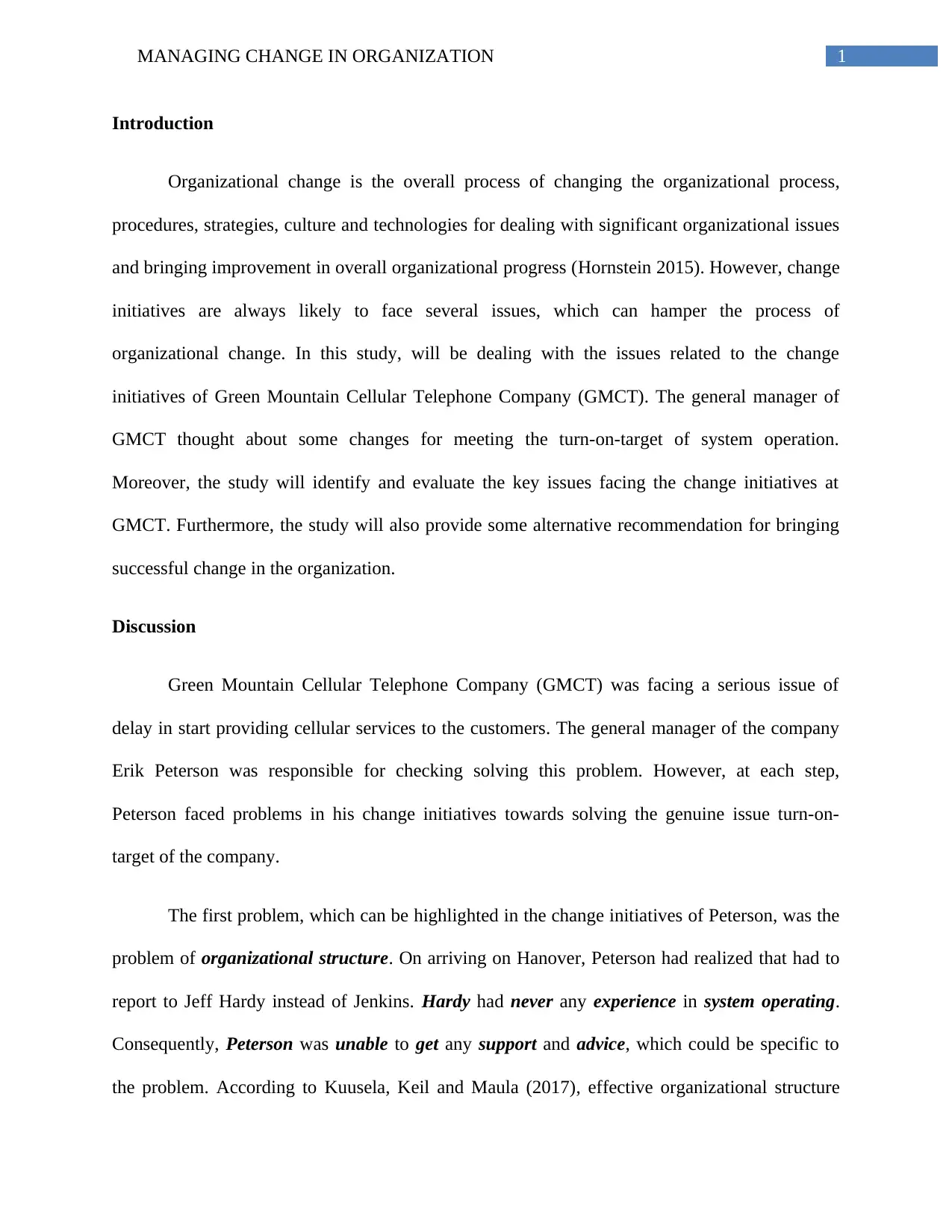
1MANAGING CHANGE IN ORGANIZATION
Introduction
Organizational change is the overall process of changing the organizational process,
procedures, strategies, culture and technologies for dealing with significant organizational issues
and bringing improvement in overall organizational progress (Hornstein 2015). However, change
initiatives are always likely to face several issues, which can hamper the process of
organizational change. In this study, will be dealing with the issues related to the change
initiatives of Green Mountain Cellular Telephone Company (GMCT). The general manager of
GMCT thought about some changes for meeting the turn-on-target of system operation.
Moreover, the study will identify and evaluate the key issues facing the change initiatives at
GMCT. Furthermore, the study will also provide some alternative recommendation for bringing
successful change in the organization.
Discussion
Green Mountain Cellular Telephone Company (GMCT) was facing a serious issue of
delay in start providing cellular services to the customers. The general manager of the company
Erik Peterson was responsible for checking solving this problem. However, at each step,
Peterson faced problems in his change initiatives towards solving the genuine issue turn-on-
target of the company.
The first problem, which can be highlighted in the change initiatives of Peterson, was the
problem of organizational structure. On arriving on Hanover, Peterson had realized that had to
report to Jeff Hardy instead of Jenkins. Hardy had never any experience in system operating.
Consequently, Peterson was unable to get any support and advice, which could be specific to
the problem. According to Kuusela, Keil and Maula (2017), effective organizational structure
Introduction
Organizational change is the overall process of changing the organizational process,
procedures, strategies, culture and technologies for dealing with significant organizational issues
and bringing improvement in overall organizational progress (Hornstein 2015). However, change
initiatives are always likely to face several issues, which can hamper the process of
organizational change. In this study, will be dealing with the issues related to the change
initiatives of Green Mountain Cellular Telephone Company (GMCT). The general manager of
GMCT thought about some changes for meeting the turn-on-target of system operation.
Moreover, the study will identify and evaluate the key issues facing the change initiatives at
GMCT. Furthermore, the study will also provide some alternative recommendation for bringing
successful change in the organization.
Discussion
Green Mountain Cellular Telephone Company (GMCT) was facing a serious issue of
delay in start providing cellular services to the customers. The general manager of the company
Erik Peterson was responsible for checking solving this problem. However, at each step,
Peterson faced problems in his change initiatives towards solving the genuine issue turn-on-
target of the company.
The first problem, which can be highlighted in the change initiatives of Peterson, was the
problem of organizational structure. On arriving on Hanover, Peterson had realized that had to
report to Jeff Hardy instead of Jenkins. Hardy had never any experience in system operating.
Consequently, Peterson was unable to get any support and advice, which could be specific to
the problem. According to Kuusela, Keil and Maula (2017), effective organizational structure

2MANAGING CHANGE IN ORGANIZATION
follows smooth flow of information between upper level and lower level managers dealing with
the serious issues of organization. Furthermore, the conflicting relationship among different
levels of managers ultimately hampers the main organizational focus (Shah, Irani and Sharif
2017). Likewise, in GMCT, there was a conflicting relationship between the Peterson and
Hardy in regards to solving the issue of delay in turn-on-date. Furthermore, Hardy was not also
able to provide any specific advice to Peterson for resolving the issue. Hence, Peterson faced
issue in his further thinking to take the change initiatives. On the other hand, Al-Haddad and
Kotnour (2015) opined that unambiguous relationship between the managers of difference
hierarchy leads to shift of organizational focus from the main concern. Likewise, ambiguous
relation between Hardy and Peterson hindered their ability to focus on their change initiatives.
Upon arrival on Hanover, Peterson discovered that initial construction of cellular tower
was several weeks behind the schedule. Moreover, the construction of cellular tower was being
performed by a subcontractor, who would never be able to meet the turn-on-target because of
their slow rate of working. The organization was also receiving increasing numbers of
complaints from the locality, as the subcontractor was cutting the privately owned tree and
property. In such situation, Peterson wanted to replace the subcontractor and contact a new
construction company for the betterment of construction of cellular tower. However, the
management of the head quarter of GMCT was reluctant for this decision. This issue was related
to resistance to change on the part of management body.
According to Lord, Dinh and Hoffman (2015), organizational members are often resistant
to change because of the fear of faulty implementation approach. Likewise, the management
body was unsupportive to Peterson in terms of replacing the subcontractor, as they assumed
replacing them can lead to increasing issues. On the other hand, Cordery et al. (2015) opined that
follows smooth flow of information between upper level and lower level managers dealing with
the serious issues of organization. Furthermore, the conflicting relationship among different
levels of managers ultimately hampers the main organizational focus (Shah, Irani and Sharif
2017). Likewise, in GMCT, there was a conflicting relationship between the Peterson and
Hardy in regards to solving the issue of delay in turn-on-date. Furthermore, Hardy was not also
able to provide any specific advice to Peterson for resolving the issue. Hence, Peterson faced
issue in his further thinking to take the change initiatives. On the other hand, Al-Haddad and
Kotnour (2015) opined that unambiguous relationship between the managers of difference
hierarchy leads to shift of organizational focus from the main concern. Likewise, ambiguous
relation between Hardy and Peterson hindered their ability to focus on their change initiatives.
Upon arrival on Hanover, Peterson discovered that initial construction of cellular tower
was several weeks behind the schedule. Moreover, the construction of cellular tower was being
performed by a subcontractor, who would never be able to meet the turn-on-target because of
their slow rate of working. The organization was also receiving increasing numbers of
complaints from the locality, as the subcontractor was cutting the privately owned tree and
property. In such situation, Peterson wanted to replace the subcontractor and contact a new
construction company for the betterment of construction of cellular tower. However, the
management of the head quarter of GMCT was reluctant for this decision. This issue was related
to resistance to change on the part of management body.
According to Lord, Dinh and Hoffman (2015), organizational members are often resistant
to change because of the fear of faulty implementation approach. Likewise, the management
body was unsupportive to Peterson in terms of replacing the subcontractor, as they assumed
replacing them can lead to increasing issues. On the other hand, Cordery et al. (2015) opined that
⊘ This is a preview!⊘
Do you want full access?
Subscribe today to unlock all pages.

Trusted by 1+ million students worldwide
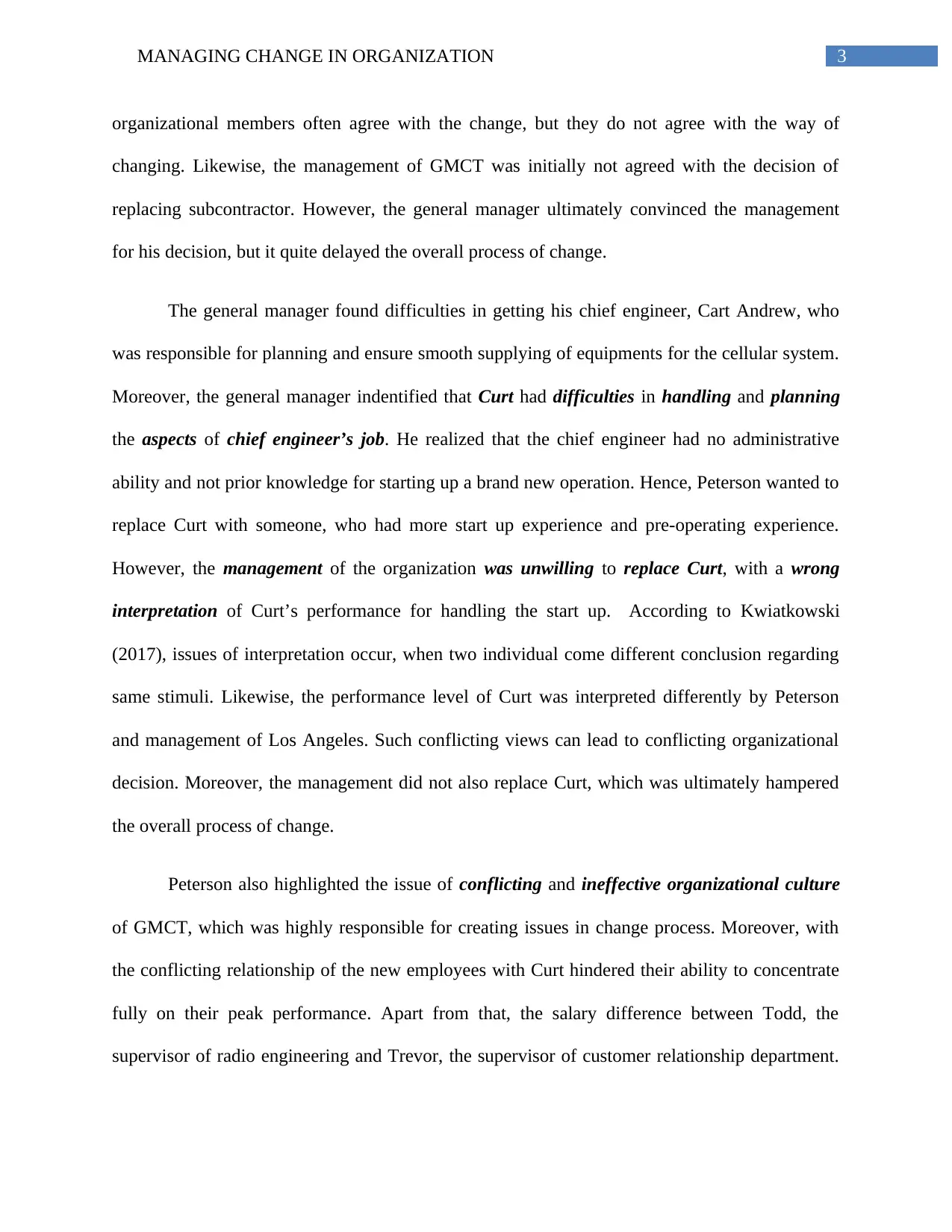
3MANAGING CHANGE IN ORGANIZATION
organizational members often agree with the change, but they do not agree with the way of
changing. Likewise, the management of GMCT was initially not agreed with the decision of
replacing subcontractor. However, the general manager ultimately convinced the management
for his decision, but it quite delayed the overall process of change.
The general manager found difficulties in getting his chief engineer, Cart Andrew, who
was responsible for planning and ensure smooth supplying of equipments for the cellular system.
Moreover, the general manager indentified that Curt had difficulties in handling and planning
the aspects of chief engineer’s job. He realized that the chief engineer had no administrative
ability and not prior knowledge for starting up a brand new operation. Hence, Peterson wanted to
replace Curt with someone, who had more start up experience and pre-operating experience.
However, the management of the organization was unwilling to replace Curt, with a wrong
interpretation of Curt’s performance for handling the start up. According to Kwiatkowski
(2017), issues of interpretation occur, when two individual come different conclusion regarding
same stimuli. Likewise, the performance level of Curt was interpreted differently by Peterson
and management of Los Angeles. Such conflicting views can lead to conflicting organizational
decision. Moreover, the management did not also replace Curt, which was ultimately hampered
the overall process of change.
Peterson also highlighted the issue of conflicting and ineffective organizational culture
of GMCT, which was highly responsible for creating issues in change process. Moreover, with
the conflicting relationship of the new employees with Curt hindered their ability to concentrate
fully on their peak performance. Apart from that, the salary difference between Todd, the
supervisor of radio engineering and Trevor, the supervisor of customer relationship department.
organizational members often agree with the change, but they do not agree with the way of
changing. Likewise, the management of GMCT was initially not agreed with the decision of
replacing subcontractor. However, the general manager ultimately convinced the management
for his decision, but it quite delayed the overall process of change.
The general manager found difficulties in getting his chief engineer, Cart Andrew, who
was responsible for planning and ensure smooth supplying of equipments for the cellular system.
Moreover, the general manager indentified that Curt had difficulties in handling and planning
the aspects of chief engineer’s job. He realized that the chief engineer had no administrative
ability and not prior knowledge for starting up a brand new operation. Hence, Peterson wanted to
replace Curt with someone, who had more start up experience and pre-operating experience.
However, the management of the organization was unwilling to replace Curt, with a wrong
interpretation of Curt’s performance for handling the start up. According to Kwiatkowski
(2017), issues of interpretation occur, when two individual come different conclusion regarding
same stimuli. Likewise, the performance level of Curt was interpreted differently by Peterson
and management of Los Angeles. Such conflicting views can lead to conflicting organizational
decision. Moreover, the management did not also replace Curt, which was ultimately hampered
the overall process of change.
Peterson also highlighted the issue of conflicting and ineffective organizational culture
of GMCT, which was highly responsible for creating issues in change process. Moreover, with
the conflicting relationship of the new employees with Curt hindered their ability to concentrate
fully on their peak performance. Apart from that, the salary difference between Todd, the
supervisor of radio engineering and Trevor, the supervisor of customer relationship department.
Paraphrase This Document
Need a fresh take? Get an instant paraphrase of this document with our AI Paraphraser
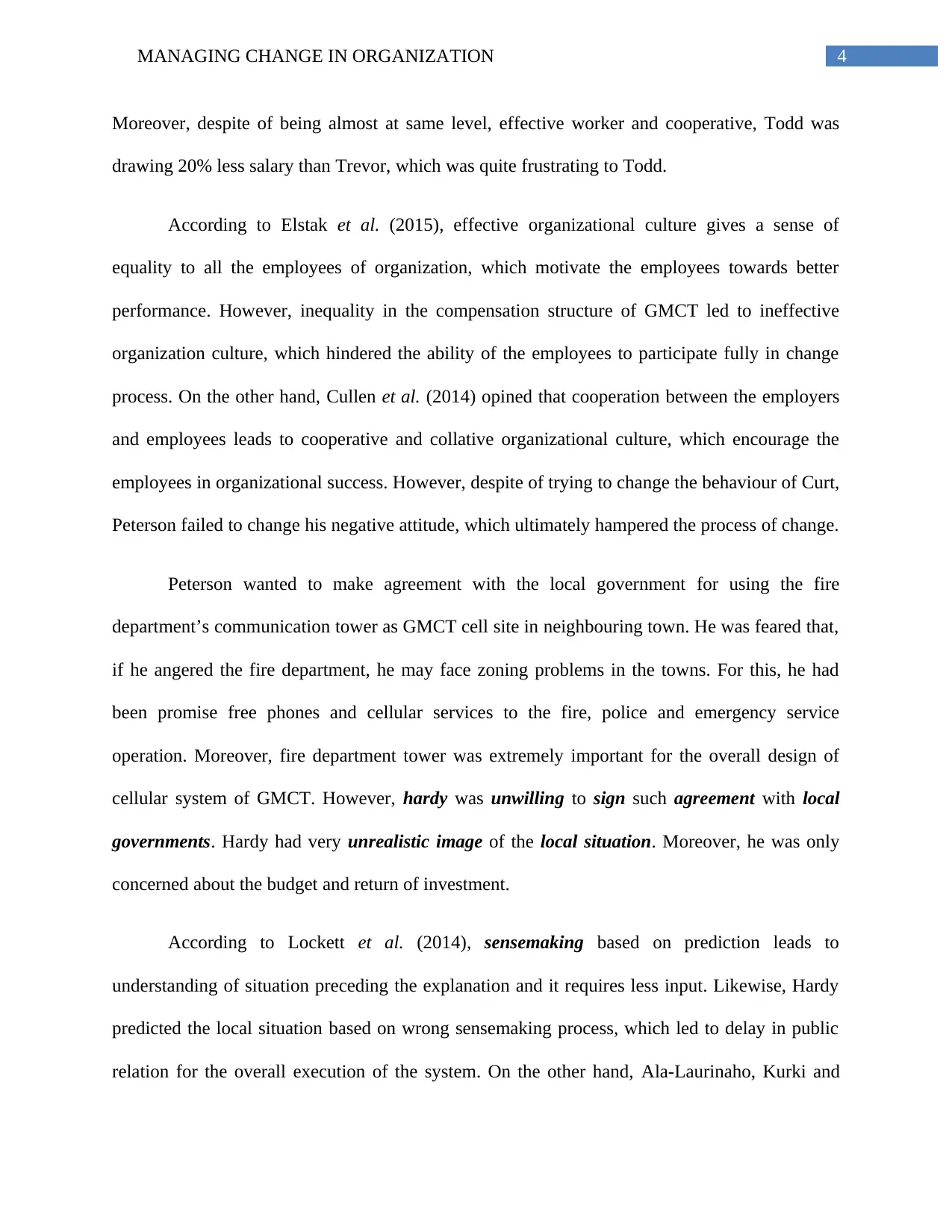
4MANAGING CHANGE IN ORGANIZATION
Moreover, despite of being almost at same level, effective worker and cooperative, Todd was
drawing 20% less salary than Trevor, which was quite frustrating to Todd.
According to Elstak et al. (2015), effective organizational culture gives a sense of
equality to all the employees of organization, which motivate the employees towards better
performance. However, inequality in the compensation structure of GMCT led to ineffective
organization culture, which hindered the ability of the employees to participate fully in change
process. On the other hand, Cullen et al. (2014) opined that cooperation between the employers
and employees leads to cooperative and collative organizational culture, which encourage the
employees in organizational success. However, despite of trying to change the behaviour of Curt,
Peterson failed to change his negative attitude, which ultimately hampered the process of change.
Peterson wanted to make agreement with the local government for using the fire
department’s communication tower as GMCT cell site in neighbouring town. He was feared that,
if he angered the fire department, he may face zoning problems in the towns. For this, he had
been promise free phones and cellular services to the fire, police and emergency service
operation. Moreover, fire department tower was extremely important for the overall design of
cellular system of GMCT. However, hardy was unwilling to sign such agreement with local
governments. Hardy had very unrealistic image of the local situation. Moreover, he was only
concerned about the budget and return of investment.
According to Lockett et al. (2014), sensemaking based on prediction leads to
understanding of situation preceding the explanation and it requires less input. Likewise, Hardy
predicted the local situation based on wrong sensemaking process, which led to delay in public
relation for the overall execution of the system. On the other hand, Ala-Laurinaho, Kurki and
Moreover, despite of being almost at same level, effective worker and cooperative, Todd was
drawing 20% less salary than Trevor, which was quite frustrating to Todd.
According to Elstak et al. (2015), effective organizational culture gives a sense of
equality to all the employees of organization, which motivate the employees towards better
performance. However, inequality in the compensation structure of GMCT led to ineffective
organization culture, which hindered the ability of the employees to participate fully in change
process. On the other hand, Cullen et al. (2014) opined that cooperation between the employers
and employees leads to cooperative and collative organizational culture, which encourage the
employees in organizational success. However, despite of trying to change the behaviour of Curt,
Peterson failed to change his negative attitude, which ultimately hampered the process of change.
Peterson wanted to make agreement with the local government for using the fire
department’s communication tower as GMCT cell site in neighbouring town. He was feared that,
if he angered the fire department, he may face zoning problems in the towns. For this, he had
been promise free phones and cellular services to the fire, police and emergency service
operation. Moreover, fire department tower was extremely important for the overall design of
cellular system of GMCT. However, hardy was unwilling to sign such agreement with local
governments. Hardy had very unrealistic image of the local situation. Moreover, he was only
concerned about the budget and return of investment.
According to Lockett et al. (2014), sensemaking based on prediction leads to
understanding of situation preceding the explanation and it requires less input. Likewise, Hardy
predicted the local situation based on wrong sensemaking process, which led to delay in public
relation for the overall execution of the system. On the other hand, Ala-Laurinaho, Kurki and
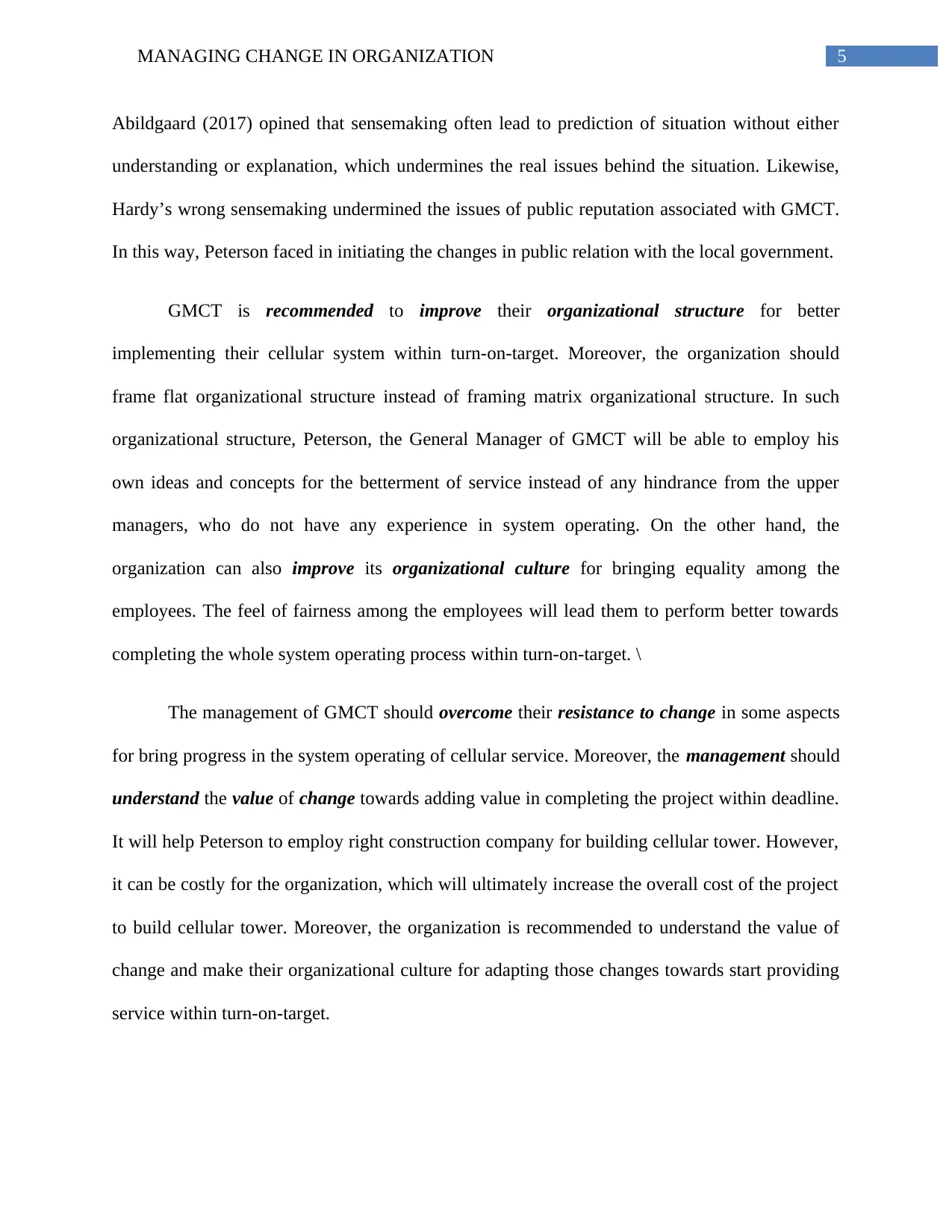
5MANAGING CHANGE IN ORGANIZATION
Abildgaard (2017) opined that sensemaking often lead to prediction of situation without either
understanding or explanation, which undermines the real issues behind the situation. Likewise,
Hardy’s wrong sensemaking undermined the issues of public reputation associated with GMCT.
In this way, Peterson faced in initiating the changes in public relation with the local government.
GMCT is recommended to improve their organizational structure for better
implementing their cellular system within turn-on-target. Moreover, the organization should
frame flat organizational structure instead of framing matrix organizational structure. In such
organizational structure, Peterson, the General Manager of GMCT will be able to employ his
own ideas and concepts for the betterment of service instead of any hindrance from the upper
managers, who do not have any experience in system operating. On the other hand, the
organization can also improve its organizational culture for bringing equality among the
employees. The feel of fairness among the employees will lead them to perform better towards
completing the whole system operating process within turn-on-target. \
The management of GMCT should overcome their resistance to change in some aspects
for bring progress in the system operating of cellular service. Moreover, the management should
understand the value of change towards adding value in completing the project within deadline.
It will help Peterson to employ right construction company for building cellular tower. However,
it can be costly for the organization, which will ultimately increase the overall cost of the project
to build cellular tower. Moreover, the organization is recommended to understand the value of
change and make their organizational culture for adapting those changes towards start providing
service within turn-on-target.
Abildgaard (2017) opined that sensemaking often lead to prediction of situation without either
understanding or explanation, which undermines the real issues behind the situation. Likewise,
Hardy’s wrong sensemaking undermined the issues of public reputation associated with GMCT.
In this way, Peterson faced in initiating the changes in public relation with the local government.
GMCT is recommended to improve their organizational structure for better
implementing their cellular system within turn-on-target. Moreover, the organization should
frame flat organizational structure instead of framing matrix organizational structure. In such
organizational structure, Peterson, the General Manager of GMCT will be able to employ his
own ideas and concepts for the betterment of service instead of any hindrance from the upper
managers, who do not have any experience in system operating. On the other hand, the
organization can also improve its organizational culture for bringing equality among the
employees. The feel of fairness among the employees will lead them to perform better towards
completing the whole system operating process within turn-on-target. \
The management of GMCT should overcome their resistance to change in some aspects
for bring progress in the system operating of cellular service. Moreover, the management should
understand the value of change towards adding value in completing the project within deadline.
It will help Peterson to employ right construction company for building cellular tower. However,
it can be costly for the organization, which will ultimately increase the overall cost of the project
to build cellular tower. Moreover, the organization is recommended to understand the value of
change and make their organizational culture for adapting those changes towards start providing
service within turn-on-target.
⊘ This is a preview!⊘
Do you want full access?
Subscribe today to unlock all pages.

Trusted by 1+ million students worldwide
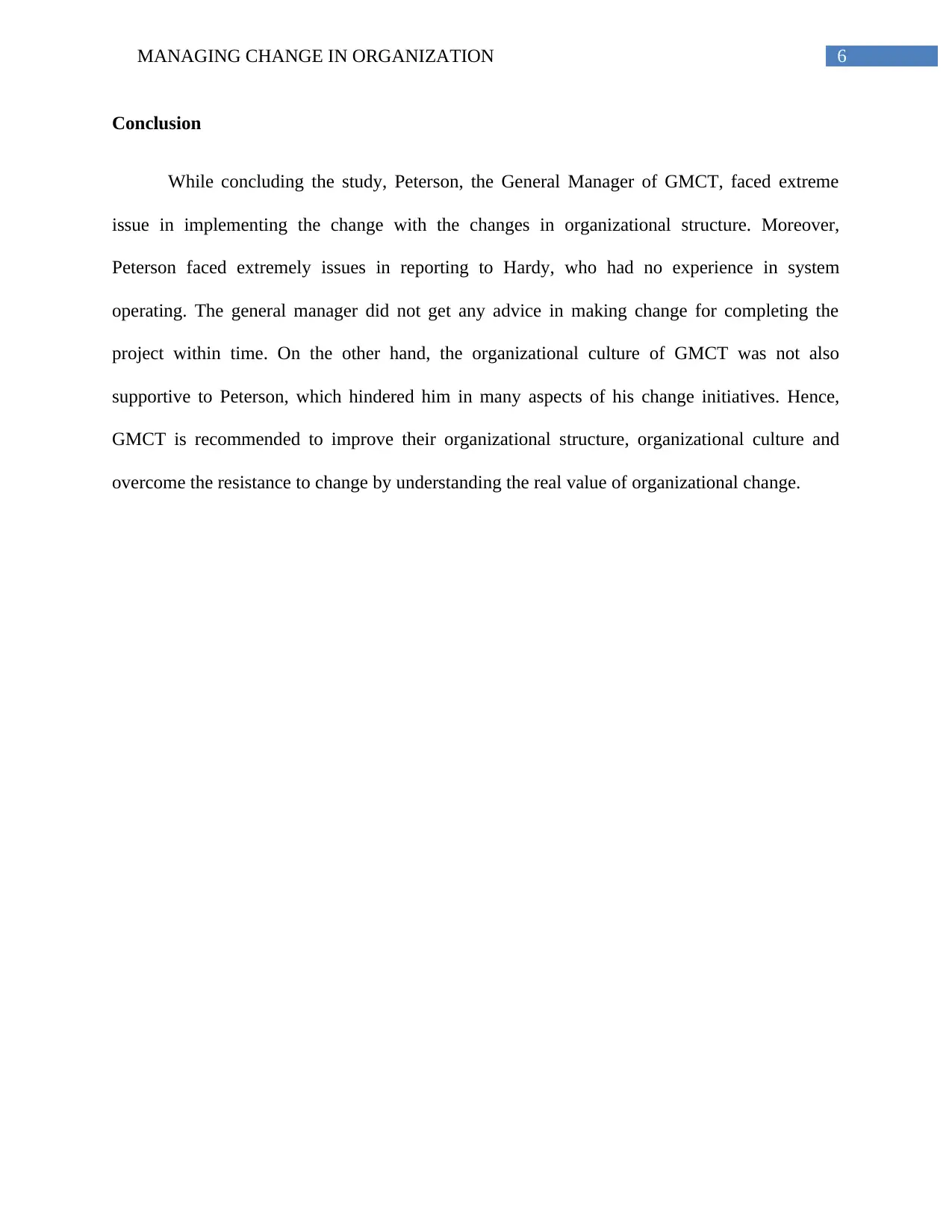
6MANAGING CHANGE IN ORGANIZATION
Conclusion
While concluding the study, Peterson, the General Manager of GMCT, faced extreme
issue in implementing the change with the changes in organizational structure. Moreover,
Peterson faced extremely issues in reporting to Hardy, who had no experience in system
operating. The general manager did not get any advice in making change for completing the
project within time. On the other hand, the organizational culture of GMCT was not also
supportive to Peterson, which hindered him in many aspects of his change initiatives. Hence,
GMCT is recommended to improve their organizational structure, organizational culture and
overcome the resistance to change by understanding the real value of organizational change.
Conclusion
While concluding the study, Peterson, the General Manager of GMCT, faced extreme
issue in implementing the change with the changes in organizational structure. Moreover,
Peterson faced extremely issues in reporting to Hardy, who had no experience in system
operating. The general manager did not get any advice in making change for completing the
project within time. On the other hand, the organizational culture of GMCT was not also
supportive to Peterson, which hindered him in many aspects of his change initiatives. Hence,
GMCT is recommended to improve their organizational structure, organizational culture and
overcome the resistance to change by understanding the real value of organizational change.
Paraphrase This Document
Need a fresh take? Get an instant paraphrase of this document with our AI Paraphraser
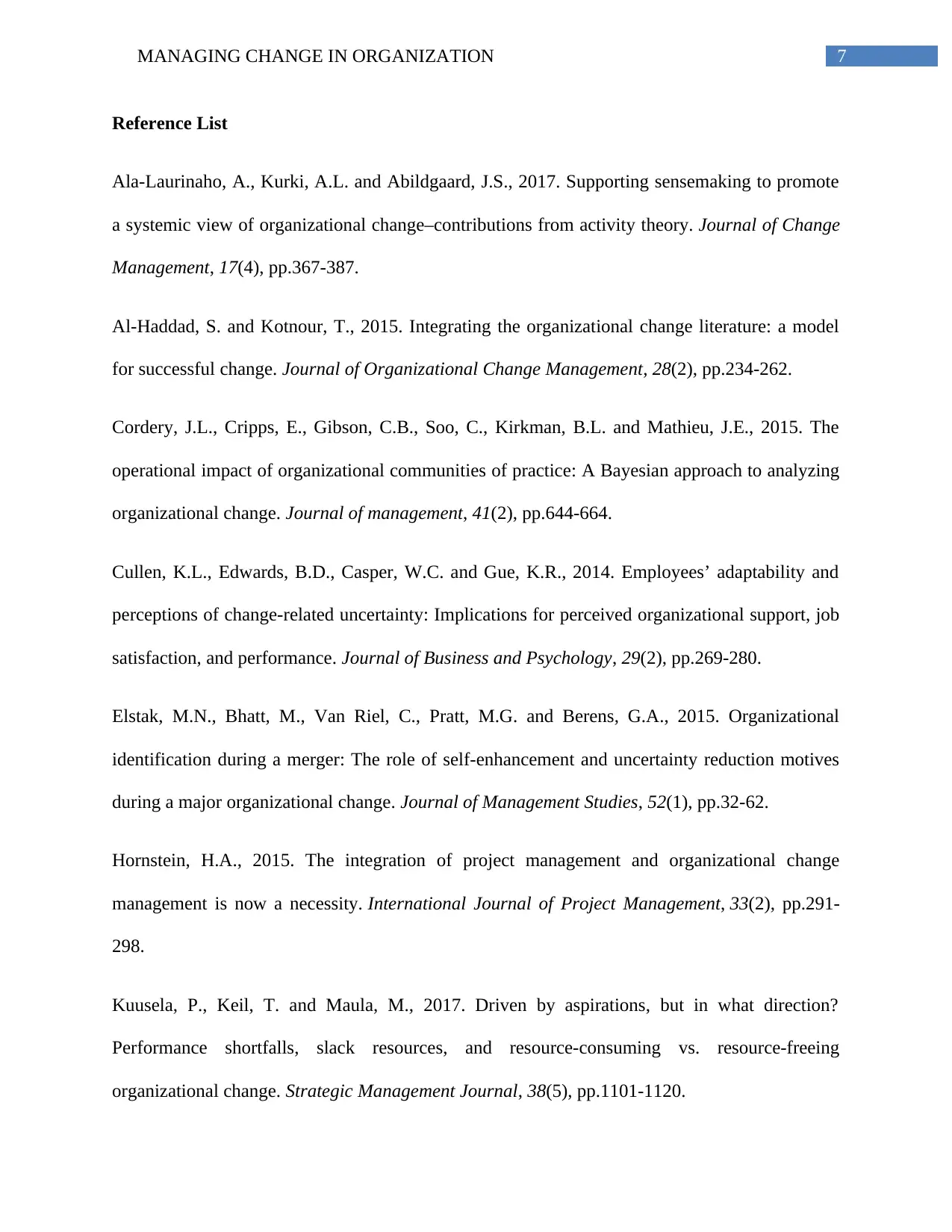
7MANAGING CHANGE IN ORGANIZATION
Reference List
Ala-Laurinaho, A., Kurki, A.L. and Abildgaard, J.S., 2017. Supporting sensemaking to promote
a systemic view of organizational change–contributions from activity theory. Journal of Change
Management, 17(4), pp.367-387.
Al-Haddad, S. and Kotnour, T., 2015. Integrating the organizational change literature: a model
for successful change. Journal of Organizational Change Management, 28(2), pp.234-262.
Cordery, J.L., Cripps, E., Gibson, C.B., Soo, C., Kirkman, B.L. and Mathieu, J.E., 2015. The
operational impact of organizational communities of practice: A Bayesian approach to analyzing
organizational change. Journal of management, 41(2), pp.644-664.
Cullen, K.L., Edwards, B.D., Casper, W.C. and Gue, K.R., 2014. Employees’ adaptability and
perceptions of change-related uncertainty: Implications for perceived organizational support, job
satisfaction, and performance. Journal of Business and Psychology, 29(2), pp.269-280.
Elstak, M.N., Bhatt, M., Van Riel, C., Pratt, M.G. and Berens, G.A., 2015. Organizational
identification during a merger: The role of self‐enhancement and uncertainty reduction motives
during a major organizational change. Journal of Management Studies, 52(1), pp.32-62.
Hornstein, H.A., 2015. The integration of project management and organizational change
management is now a necessity. International Journal of Project Management, 33(2), pp.291-
298.
Kuusela, P., Keil, T. and Maula, M., 2017. Driven by aspirations, but in what direction?
Performance shortfalls, slack resources, and resource‐consuming vs. resource‐freeing
organizational change. Strategic Management Journal, 38(5), pp.1101-1120.
Reference List
Ala-Laurinaho, A., Kurki, A.L. and Abildgaard, J.S., 2017. Supporting sensemaking to promote
a systemic view of organizational change–contributions from activity theory. Journal of Change
Management, 17(4), pp.367-387.
Al-Haddad, S. and Kotnour, T., 2015. Integrating the organizational change literature: a model
for successful change. Journal of Organizational Change Management, 28(2), pp.234-262.
Cordery, J.L., Cripps, E., Gibson, C.B., Soo, C., Kirkman, B.L. and Mathieu, J.E., 2015. The
operational impact of organizational communities of practice: A Bayesian approach to analyzing
organizational change. Journal of management, 41(2), pp.644-664.
Cullen, K.L., Edwards, B.D., Casper, W.C. and Gue, K.R., 2014. Employees’ adaptability and
perceptions of change-related uncertainty: Implications for perceived organizational support, job
satisfaction, and performance. Journal of Business and Psychology, 29(2), pp.269-280.
Elstak, M.N., Bhatt, M., Van Riel, C., Pratt, M.G. and Berens, G.A., 2015. Organizational
identification during a merger: The role of self‐enhancement and uncertainty reduction motives
during a major organizational change. Journal of Management Studies, 52(1), pp.32-62.
Hornstein, H.A., 2015. The integration of project management and organizational change
management is now a necessity. International Journal of Project Management, 33(2), pp.291-
298.
Kuusela, P., Keil, T. and Maula, M., 2017. Driven by aspirations, but in what direction?
Performance shortfalls, slack resources, and resource‐consuming vs. resource‐freeing
organizational change. Strategic Management Journal, 38(5), pp.1101-1120.
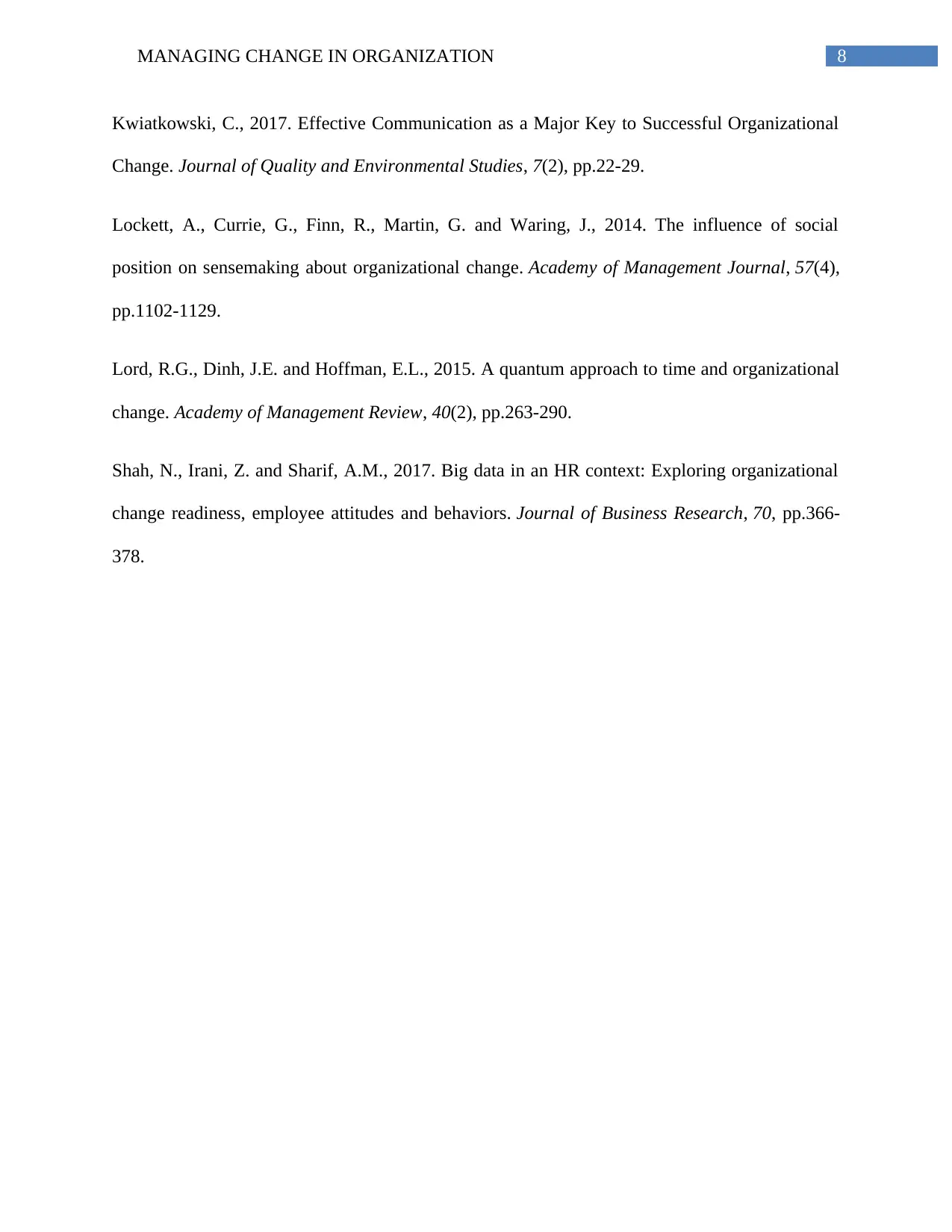
8MANAGING CHANGE IN ORGANIZATION
Kwiatkowski, C., 2017. Effective Communication as a Major Key to Successful Organizational
Change. Journal of Quality and Environmental Studies, 7(2), pp.22-29.
Lockett, A., Currie, G., Finn, R., Martin, G. and Waring, J., 2014. The influence of social
position on sensemaking about organizational change. Academy of Management Journal, 57(4),
pp.1102-1129.
Lord, R.G., Dinh, J.E. and Hoffman, E.L., 2015. A quantum approach to time and organizational
change. Academy of Management Review, 40(2), pp.263-290.
Shah, N., Irani, Z. and Sharif, A.M., 2017. Big data in an HR context: Exploring organizational
change readiness, employee attitudes and behaviors. Journal of Business Research, 70, pp.366-
378.
Kwiatkowski, C., 2017. Effective Communication as a Major Key to Successful Organizational
Change. Journal of Quality and Environmental Studies, 7(2), pp.22-29.
Lockett, A., Currie, G., Finn, R., Martin, G. and Waring, J., 2014. The influence of social
position on sensemaking about organizational change. Academy of Management Journal, 57(4),
pp.1102-1129.
Lord, R.G., Dinh, J.E. and Hoffman, E.L., 2015. A quantum approach to time and organizational
change. Academy of Management Review, 40(2), pp.263-290.
Shah, N., Irani, Z. and Sharif, A.M., 2017. Big data in an HR context: Exploring organizational
change readiness, employee attitudes and behaviors. Journal of Business Research, 70, pp.366-
378.
⊘ This is a preview!⊘
Do you want full access?
Subscribe today to unlock all pages.

Trusted by 1+ million students worldwide
1 out of 9
Your All-in-One AI-Powered Toolkit for Academic Success.
+13062052269
info@desklib.com
Available 24*7 on WhatsApp / Email
![[object Object]](/_next/static/media/star-bottom.7253800d.svg)
Unlock your academic potential
Copyright © 2020–2025 A2Z Services. All Rights Reserved. Developed and managed by ZUCOL.


